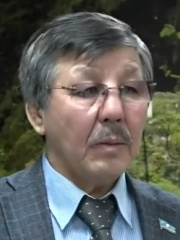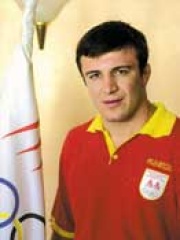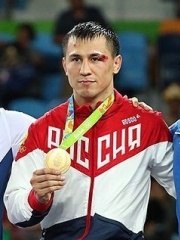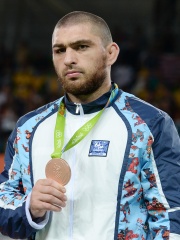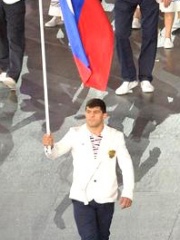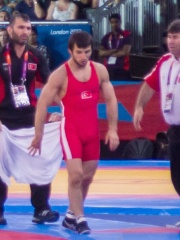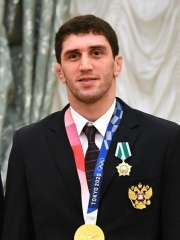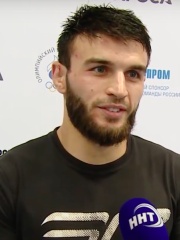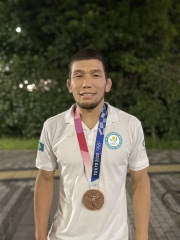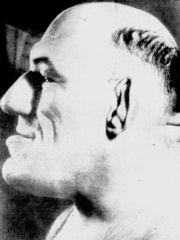
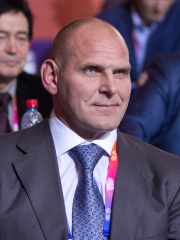
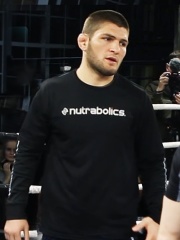
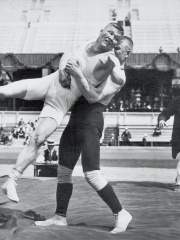
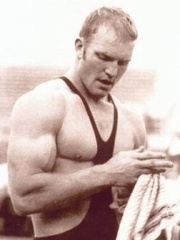
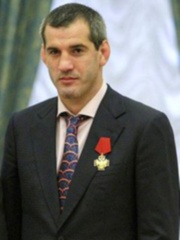
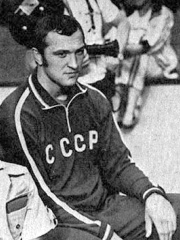
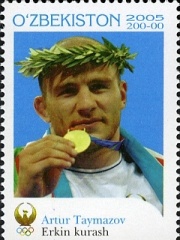
The Most Famous
WRESTLERS from Russia
This page contains a list of the greatest Russian Wrestlers. The pantheon dataset contains 700 Wrestlers, 53 of which were born in Russia. This makes Russia the birth place of the 3rd most number of Wrestlers behind United States and Japan.
Top 10
The following people are considered by Pantheon to be the top 10 most legendary Russian Wrestlers of all time. This list of famous Russian Wrestlers is sorted by HPI (Historical Popularity Index), a metric that aggregates information on a biography’s online popularity. Visit the rankings page to view the entire list of Russian Wrestlers.

1. The French Angel (1903 - 1954)
With an HPI of 64.83, The French Angel is the most famous Russian Wrestler. His biography has been translated into 21 different languages on wikipedia.
Maurice Tillet (23 October 1903 – 4 September 1954) was a Russian-French professional wrestler, better known by his ring name, The French Angel/The Angel. Tillet was a leading box office draw in the early 1940s and was twice World Heavyweight Champion in the American Wrestling Association run by Paul Bowser in Boston. It has been rumored that Tillet was the inspiration for the animated movie character Shrek based on their resemblance.

2. Aleksandr Karelin (1967 - )
With an HPI of 60.48, Aleksandr Karelin is the 2nd most famous Russian Wrestler. His biography has been translated into 53 different languages.
Aleksandr Aleksandrovich Karelin (Russian: Александр Александрович Карелин, IPA: [ɐlʲɪkˈsandr ɐlʲɪkˈsandrəvʲɪtɕ kɐˈrʲelʲɪn]; born 19 September 1967) is a Russian politician and retired athlete. Karelin competed in Greco-Roman wrestling, representing the Soviet Union and Russia between 1987 and 2000. Nicknamed the "Russian Bear", "Russian King Kong", "Alexander the Great", "The Experiment", and "The Crane from Novosibirsk", he is widely considered to be the greatest and most dominant Greco-Roman wrestler of all time. Karelin won gold medals at the 1988, 1992, and 1996 Olympic Games under a different flag each time (Soviet Union, Unified Team, and Russia respectively), and a silver medal at the 2000 Olympic Games. His wrestling record at the senior level is 887 wins and two losses, both controversial and both by a single point. Prior to his defeat to American Rulon Gardner at the 2000 Olympics finals, a point had not been scored against him in competition the previous six years. He went undefeated in the world championships, having never lost a match. Karelin was the national flag bearer at three consecutive Olympics: in 1988 for the Soviet Union, in 1992 for the Unified Team, and in 1996 for Russia. In addition to his success in Greco-Roman wrestling, he was also a sambo champion during his service in the Internal Troops. Due to his dominance and accomplishments, Karelin was named as the greatest Greco-Roman wrestler of the 20th century by the International Federation of Associated Wrestling Styles (FILA), and is one of the class of ten inaugural inductees into the FILA International Wrestling Hall of Fame in 2003. In 2007, Karelin, alongside Buvaisar Saitiev, were voted the best wrestlers in the history of the sport by FILA. Four times he was awarded the "Golden Belt" as the best wrestler of the planet by FILA - in 1989, 1990, 1992, and 1994. Karelin was named a Hero of the Russian Federation in 1996. Karelin entered politics in 1999, being elected a deputy of the State Duma that year. He sat in the Duma through various convocations until 2020, when he entered the Federation Council as a senator.

3. Khabib Nurmagomedov (1988 - )
With an HPI of 55.37, Khabib Nurmagomedov is the 3rd most famous Russian Wrestler. His biography has been translated into 54 different languages.
Khabib Abdulmanapovich Nurmagomedov (born 20 September 1988) is a Russian former professional mixed martial artist who competed in the Lightweight division of the Ultimate Fighting Championship (UFC). He was the longest-reigning UFC Lightweight Champion ever, having held the title from April 2018 to March 2021. With 29 wins and no losses, he retired with an undefeated record. Nurmagomedov is widely considered to be among the greatest mixed martial artists of all time, and was inducted into the UFC Hall of Fame on June 30, 2022. A two-time world champion in combat sambo, Nurmagomedov has a background in wrestling, judo, and sambo. Nurmagomedov was ranked #1 in the UFC men's pound-for-pound rankings at the time of his retirement, until being removed following his title vacation in March 2021. Fight Matrix ranks him as the #1 lightweight of all time. In 2019, Forbes ranked Nurmagomedov as the No. 1 most successful Russian athlete; Nurmagomedov also topped the list of the 40 most successful Russian show business and sports personalities under 40. Nurmagomedov is also a mixed martial arts trainer and promoter, known for founding Eagles MMA and promoting the Eagle Fighting Championship (EFC). After retirement, he transitioned to being a full-time coach and cornerman before retiring from the sport completely in January 2023. Throughout his career, Nurmagomedov has become the subject of many controversies, including a longstanding affiliation with Chechnya's leader, Ramzan Kadyrov, questionable affiliations with oligarchs, advocacy for increased cultural censorship and misogynism.

4. Alfred Asikainen (1888 - 1942)
With an HPI of 48.30, Alfred Asikainen is the 4th most famous Russian Wrestler. His biography has been translated into 15 different languages.
Alfred Johan "Alpo" Asikainen (2 November 1888 – 7 January 1942) was a Finnish wrestler who competed in the 1912 Summer Olympics, winning the bronze medal.
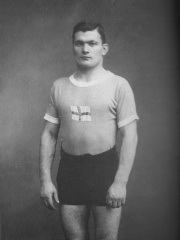
5. Oskari Friman (1893 - 1933)
With an HPI of 47.36, Oskari Friman is the 5th most famous Russian Wrestler. His biography has been translated into 18 different languages.
Oskar David "Oskari" Friman (27 January 1893 – 19 October 1933) was a Greco-Roman wrestler from Finland. He won gold medals in lightweight categories at the 1920 and 1924 Olympics and 1921 World Championships. Nationally he collected eleven Finnish titles, in 1915-1924 and 1928. Friman took up wrestling in 1908, and by 1915 became one of the best Finnish lightweight wrestlers, together with his clubmate Emil Väre. Because of World War I, he started competing internationally only at the 1920 Olympics, where he dropped to featherweight to avoid meeting Väre. Väre retired soon after that, and Friman returned to lightweight. During those years he worked as a butcher and tinsmith, but later, when he became famous and retired from competitions, he was hired as head coach of the Finnish and Swedish national wrestling teams.

6. Ivan Yarygin (1948 - 1997)
With an HPI of 45.94, Ivan Yarygin is the 6th most famous Russian Wrestler. His biography has been translated into 16 different languages.
Ivan Sergeyevich Yarygin (Russian: Иван Сергеевич Ярыгин, IPA: [ɪˈvan sʲɪrˈɡʲe(j)ɪvʲɪtɕ jɪˈrɨɡʲɪn]; 7 November 1948 – 11 October 1997) was a Soviet and Russian heavyweight freestyle wrestler. Between 1970 and 1980 he won all his major international competitions, except for the 1970 and 1974 European championships where he placed second. Yarygin was an Olympic champion in 1972 and 1976, being the first wrestler to go through an Olympic competition with straight pin victories and no foul points, a world champion in 1973, a World Cup winner five times, has never lost a single match in World Cup competition, and a European champion in 1972 and 1975–76, and won a world cup in 1973, 1976–77 and 1979–80. He also set a record for the fastest pin victory in the World Cup history at 27 seconds. After retiring in 1980, he headed the Soviet freestyle wrestling team from 1982 to 1992 and the Russian Wrestling Federation from 1993 until his untimely death in a car crash in 1997. An exceptional upper-body wrestler, Yarygin was widely regarded for his tremendous physique and high-strength aggressive style, always aiming to pin down his opponents, with most of his stoppage wins came by way of fall achieved through rapid fireman's lift and slamming the opponent to the mat. One of the most prestigious tournaments in the World was put together in his honor - The Golden Grand Prix Ivan Yarygin Tournament is held annually in Krasnoyarsk, Russia, and has the reputation of being one of the hardest tournaments in the World. The Yarygin Memorial annually sees the world's best wrestlers come to Siberia, with the added element that Russia's autonomous oblasts and republics such as Dagestan and Chechnya field independent teams alongside an All-Russia selection.

7. Buvaisar Saitiev (1975 - )
With an HPI of 45.21, Buvaisar Saitiev is the 7th most famous Russian Wrestler. His biography has been translated into 33 different languages.
Buvaisar Hamidovich Saitiev, also spelled Buvaysar Hamidovich Saytiev, (Russian: Бувайсар Хамидович Сайтиев, Chechen: Сайт КIант Бувайса) (born March 11, 1975) is a Russian retired freestyle wrestler of Chechen heritage, who represented Russia, and won nine world-level gold medals in freestyle wrestling (second most, behind Aleksandr Medved's ten). He is widely considered as the greatest freestyle wrestler of all time. He currently is an acting State Duma Deputy from Dagestan.

8. Soslan Andiyev (1952 - 2018)
With an HPI of 42.53, Soslan Andiyev is the 8th most famous Russian Wrestler. Her biography has been translated into 17 different languages.
Soslan Petrovich Andiyev (Ossetian: Андиаты Пётры фырт Сослан, Russian: Сослан Петрович Андиев, 21 April 1952 – 22 November 2018) was a Soviet heavyweight freestyle wrestler. He was an Olympic champion in 1976 and 1980, world champion in 1973, 1975, 1977 and 1978, European champion in 1974, 1975 and 1982, and Soviet champion in 1973–78 and 1980. He won the World Cup in 1976 and 1981, but missed the 1984 Olympics due to their boycott by the Soviet Union and retired the same year. After that he first worked as a national wrestling coach, but in 1989 returned to his native Ossetia to become a sports functionary. In 1990–98, he served as vice-president of the Russian Olympic Committee. In 2006 he was inducted into the FILA Wrestling Hall of Fame. Andiyev had one sister, Svetlana, and two brothers, Genady and Sergey; both were leading Soviet heavyweight freestyle wrestlers. Their mother was Russian and father was Ossetian. The senior male Andiyev was 2.18 m tall and weighed 136 kg, and was a regional wrestling champion; he died when Soslan was eight years old. Genady, at 18 years old, was the eldest sibling at the time; he became head of the family and later coached Soslan. Four years later, in 1964, he brought Soslan to the wrestling club, to continue the family tradition. In 1971 Genady, Sergey and Soslan placed first, second and third, respectively, at the Russian championships. In 1974 Andiyev graduated from the Vladikavkaz Agricultural University and began working on a PhD, but soon abandoned it in favor of wrestling. Between 1975 and 1989 he worked as a sports instructor for the Ossetian Police, which allowed him to train and compete. After retiring from competitions, between 1985 and 1989 he worked as a national wrestling coach. In 1989 he returned to Ossetia to assume the post of the Ossetian Minister of Sport. Andiyev was married with three daughters, Zarina (b. 1978), Mariya (b. 1980) and Lina (b. 1985) and son Georgy (b. 1992).

9. Artur Taymazov (1979 - )
With an HPI of 39.11, Artur Taymazov is the 9th most famous Russian Wrestler. His biography has been translated into 24 different languages.
Artur Borisovich Taymazov (Ossetian: Таймазты Барисы фырт Артур; Russian: Артур Борисович Таймазов; born 20 July 1979) is Uzbek-Russian wrestler and politician. He was Uzbekistan's most decorated Olympian before being stripped of two gold medals for doping. In 2016, he was elected to the 7th State Duma of the Russian Federation representing United Russia. On 5 April 2017, it was announced that as a result of retesting samples he had been disqualified from the 2008 Olympics for a drug violation, and his gold medal was withdrawn. On 23 July 2019, it was announced that as a result of retesting samples he had been disqualified from the 2012 Olympics for a drug violation, and his gold medal from that event was also withdrawn. As both of his gold medals were re-allocated to Russian wrestlers, Taymazov said he was nonetheless happy to "bring" two golds to Russia.
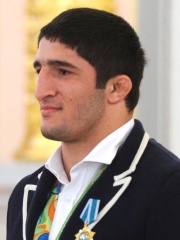
10. Abdulrashid Sadulaev (1996 - )
With an HPI of 38.19, Abdulrashid Sadulaev is the 10th most famous Russian Wrestler. His biography has been translated into 24 different languages.
Abdulrashid Bulachevich Sadulaev (Russian: Абдулрашид Булачевич Садулаев, IPA: [ɐbdʊɫrɐˈʂɨts sədʊˈɫa(ɪ̯)ɪf]; born 9 May 1996) is a Russian freestyle wrestler who competes at 97 kilograms and formerly competed at 86 kilograms. Sadulaev is widely regarded as the most dominant active freestyle wrestler in the world. Nicknamed the "Russian Tank," he is a two time Olympic gold medalist (2016, 2020), a five–time World Champion (2014, 2015, 2018, 2019, 2021), the Individual World Cup champion (2020), a four–time European Continental Champion (2014, 2018, 2019, 2020), Ivan Yarygin Grand Prix winner (2014, 2018) a two-time European Games Champion (2015, 2019) and a two–time Cadet World Champion (2012, 2013).
Pantheon has 53 people classified as wrestlers born between 1888 and 1996. Of these 53, 48 (90.57%) of them are still alive today. The most famous living wrestlers include Aleksandr Karelin, Khabib Nurmagomedov, and Buvaisar Saitiev. The most famous deceased wrestlers include The French Angel, Alfred Asikainen, and Oskari Friman. As of April 2022, 17 new wrestlers have been added to Pantheon including Alfred Asikainen, Ivan Yarygin, and Pavel Pinigin.
Living Wrestlers
Go to all Rankings
Aleksandr Karelin
1967 - Present
HPI: 60.48
Khabib Nurmagomedov
1988 - Present
HPI: 55.37
Buvaisar Saitiev
1975 - Present
HPI: 45.21
Artur Taymazov
1979 - Present
HPI: 39.11
Abdulrashid Sadulaev
1996 - Present
HPI: 38.19
Pavel Pinigin
1953 - Present
HPI: 37.95
Hüseyin Özkan
1972 - Present
HPI: 37.17
Adam Saitiev
1977 - Present
HPI: 36.62
Magomed Ibragimov
1974 - Present
HPI: 36.07
David Musulbes
1972 - Present
HPI: 36.04
Roman Vlasov
1990 - Present
HPI: 35.51
Sharif Sharifov
1988 - Present
HPI: 35.01

Deceased Wrestlers
Go to all Rankings
The French Angel
1903 - 1954
HPI: 64.83
Alfred Asikainen
1888 - 1942
HPI: 48.30
Oskari Friman
1893 - 1933
HPI: 47.36
Ivan Yarygin
1948 - 1997
HPI: 45.94
Soslan Andiyev
1952 - 2018
HPI: 42.53

Newly Added Wrestlers (2022)
Go to all Rankings
Alfred Asikainen
1888 - 1942
HPI: 48.30
Ivan Yarygin
1948 - 1997
HPI: 45.94
Pavel Pinigin
1953 - Present
HPI: 37.95
Khadzhimurat Gatsalov
1982 - Present
HPI: 34.40
Sagid Murtazaliev
1974 - Present
HPI: 32.90
Ramazan Şahin
1983 - Present
HPI: 32.28
Zaurbek Sidakov
1996 - Present
HPI: 31.17
Tamerlan Tmenov
1977 - Present
HPI: 29.09
Vitaly Makarov
1974 - Present
HPI: 28.86
Murad Umakhanov
1977 - Present
HPI: 28.78
Gadzhimurad Rashidov
1995 - Present
HPI: 28.40
Nurislam Sanayev
1991 - Present
HPI: 27.54

Which Wrestlers were alive at the same time? This visualization shows the lifespans of the 4 most globally memorable Wrestlers since 1700.

